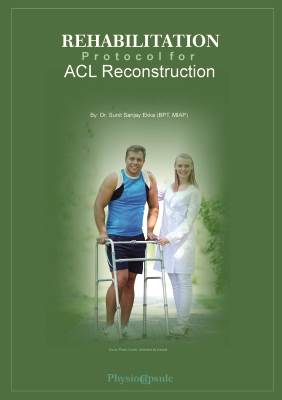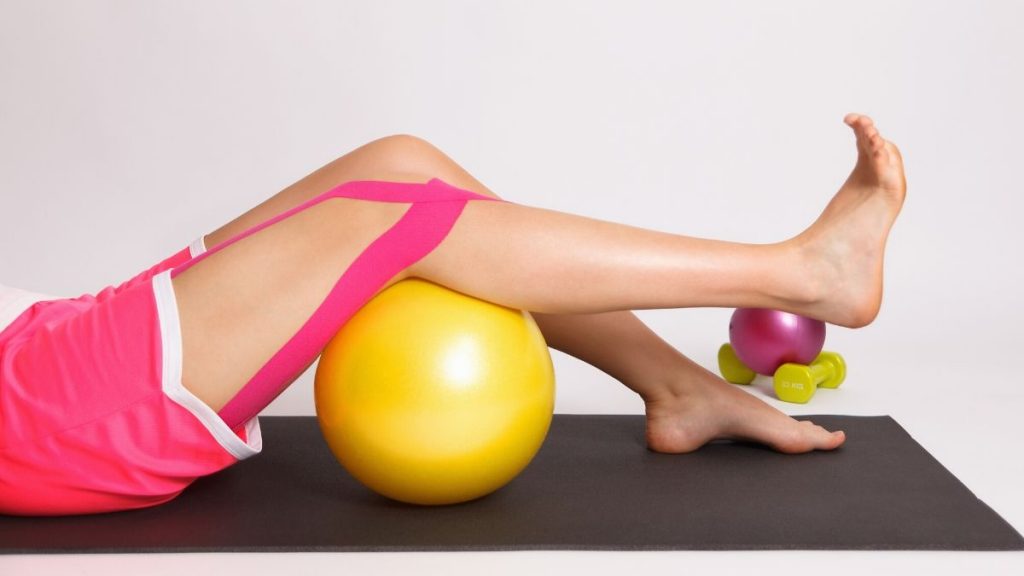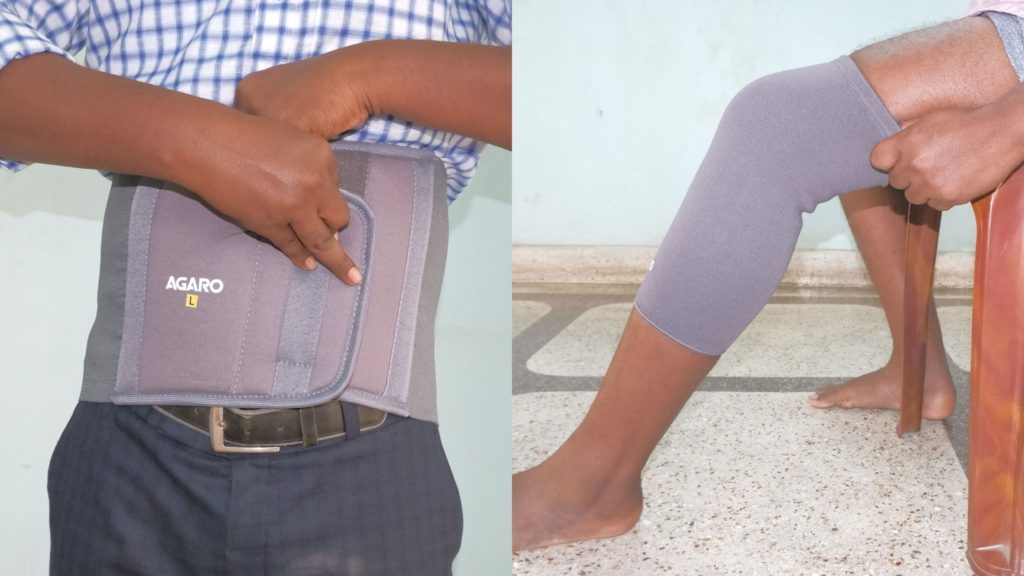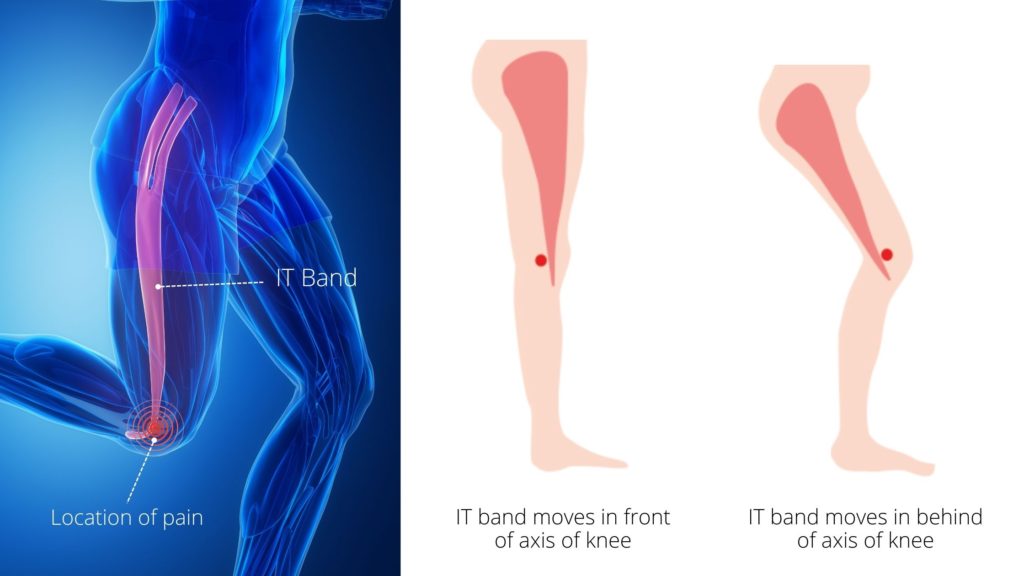Last updated on June 8th, 2022 at 06:41 pm

Postoperatively ACL reconstruction surgery needs to follow a strict ACL reconstruction protocol. The exercises and protocol start right after the next day of surgery when you have to exercise on the hospital bed itself. It
- Principles of ACL reconstruction protocol
- Physiotherapy protocol for ACL reconstruction
- ACL rehabilitation protocol with colorful photos in PDF?
Principles of ACL reconstruction protocol
Research has found that rehabilitation before surgery improves the outcome after surgery. It is important to reduce swelling, inflammation, and pain, restore normal ROM, normalize walking, and prevent muscle atrophy prior to surgery. The goal of the preoperative rehabilitation is to return the knee to its preinjury, normalized state and to obtain tissue homeostasis (1).
The 21 days preoperative phase is typically adequate (1), you can follow exercises in this article for 21 days prior to surgery. These exercises are aimed to strengthen muscles around the knee and improve the knee’s range of motion.
In my practice, I get the opportunity to deal with lots of post-operative ACL reconstruction patients. They are a bit afraid and apprehensive to take the first step. It requires lots of self-confidence and a morale boost from physiotherapists to teach them weight bearing on the affected leg.
Standing, taking the very first step may sound silly, but for an ACL injury sufferer, it’s a struggle. Right after the injury then through the theatre, taking that first step is not easy. One has to go through a series of calculated steps of rehabilitation to reach this. Once the individual starts walking independently without walking aids the next step becomes somewhat easy. So, let us discuss the step-by-step rehabilitation process after an ACL reconstruction surgery.
In our previous article “Symptoms of a Torn ACL, What to do at Home” we already discussed the symptoms, causes and conservative management of ACL injury. A partial tear of the ligament or sprain
If there is a complete tear of the ACL or a late case with a complaint of the instability of the knee then reconstruction surgery is the only option. In this surgery, the ligament is constructed using the patient’s tendon or fascia lata. A tendon or fascia taken from another person (allograft) or a synthetic ligament has to be used.
Physiotherapy protocol for ACL reconstruction
Post-operative physiotherapy after ACL reconstruction is very important, It prevents lots of complications which otherwise would have developed. It also helps in the early rehabilitation of patent and early return to work or profession.
The reconstruction graft has to develop the blood supply and undergoes revascularization. Also, the collagen fibres realign themselves this is why the ligament injury takes longer to heal. Thus, the rehabilitation process is slow and long. Full rehabilitation can take anywhere from 6 months to 1 year. We can divide it into four phases.
- Phase-I- Maximum protection phase.
- Phase-II Moderate protection phase.
- Phase-III Minimum protection phase.
- Phase-IV Light activity phase.
Let us discuss each phase separately. Read it carefully and follow the protocol. If in doubt discuss it with your physiotherapist.
Phase-I- Maximum protection phase (0-2 weeks after surgery)

This phase is known as the maximum protection phase, as it requires immense care and protection. It starts immediately after the surgery and lasts up to 2 weeks. To prevent movement the knee joint is immobilised in a fully extended position using a brace. Strengthening exercises for the leg are encouraged with a
That is, you have to rest your knee by keeping it straight and elevated when sitting or laying down by placing a layer of two pillows beneath the lower leg. Ice packs and compression are applied to prevent swelling and inflammation. Do not rest with a towel placed under the knee as it will cause the knee to bend slightly. Support your surgical side when performing transfers (i.e. sitting to laying down).
Physiotherapy and rehabilitation during this phase are aimed to protect the graft, reduce swelling, minimize pain, restore patellar mobility, restore full extension, gradually improve flexion, minimize arthrogenic muscle inhibition, re-establish quad control, and regain full active extension (1).
Exercises for maximum protection phase
Exercises to improve knee range of motion/Mobility
- Patellar mobilizations: superior/inferior and medial/lateral
- Seated assisted knee flexion-extension and heel slides with towel
- Low intensity, long duration extension stretches: prone hang, heel prop
- Standing gastroc stretch and soleus stretch
- Supine active hamstring stretch and supine passive hamstring stretch
Knee strengthening exercises
- Ankle foot toe movement in long sitting
- Heel raises in standing
- Static quadriceps exercise
- Straight leg raise **Do not perform straight leg raise if you have a knee extension lag
- Hip abduction
- Multi-angle isometrics 90 and 60 deg knee extension
Phase-II Moderate protection phase (3-5 weeks after surgery)

We also call it a moderate protection phase. It starts from the 3rd week and lasts up to the 5th week. By the 3rd week, some of the knee strength is gained. Now, it needs only moderate protection and some degree of movement is allowed. Continue doing strengthening exercises for the
Closed chain knee exercises
Exercises (Continue with Phase I interventions)
Range of motion/Mobility
- Stationary bicycle
- Gentle stretching all muscle groups: prone quad stretch, standing quad stretch
Strengthening
- Knee bending in prone
- Step-ups and step-ups with a marching
- Partial squat exercise
- Ball squats, wall squat, mini squats from 0-60 deg
- Bridging & unilateral bridging exercise, sidelying hip external rotation, bridges on physioball, bridge on physioball with roll-in, bridge on physioball alternating
Balance/proprioception
- Single leg standing balance (knee slightly flexed) static progressed to dynamic and level
- progressed to unsteady surface
- Lateral step-overs
- Joint position re-training
Phase-III Minimum protection phase (6-12 weeks after surgery)
Also called a minimum protection phase and starts from the 6th week of surgery and lasts up to 8 weeks. By now the patient can walk with a functional brace Range of motion exercises as tolerated. Strengthening exercises are also added. We suggest close kinematic chain exercises.
Exercises (Continue with Phase I-II Interventions)
Range of motion/Mobility: Rotational tibial mobilizations if limited ROM
Cardio: 8 weeks: Elliptical, stair climber, flutter kick swimming, pool jogging
Strengthening
- Progress intensity (strength) and duration (endurance) of exercises **The following exercises to focus on proper control with emphasis on good proximal stability
- Squat to chair
- Lateral lunges
- Single leg progression: partial weight bearing single leg press, slide board lunges: retro and lateral, step ups and step ups with march, lateral step-ups, step downs, single leg squats, single leg wall slides
- Knee Exercises
- Seated Leg Extension (avoid anterior knee pain): 90-45 degrees with resistance
Balance/proprioception: Progress single limb balance including perturbation training
Phase-IV Light activity phase (3-5 months after surgery)

It is a phase between the 3rd month and to 4th month. Physiotherapy and rehabilitation in the light activity phase are aimed to safely progress the strengthening, safely initiate a sport-specific training program, promote proper movement patterns, avoid post-exercise pain/swelling, and avoid activities that produce pain at the graft donor site.
Now we should begin endurance stretching exercises. After 6 months Running initiated Stretching, strengthening, and endurance activity.
Exercises (Continue with Phase II-IV interventions)
Interval running program
o Return to Running Program
• Progress to plyometric and agility program (with functional brace if prescribed)
o Agility and Plyometric Program
ACL rehabilitation protocol with colorful photos in PDF?

Explaining and making them follow the protocol is challenging. But, we can simplify it if we see the picture/ image of each step of the
If you are an ACL injury sufferer you can use it for yourself and if you are a Physiotherapist dealing with such a case, it can prove immensely useful to you.
Return back to activity after 9 months
After nine months from the day of operation, one can return to his/ her profession after nine months.
Journal reference:
- Recent Advances in the Rehabilitation of Anterior Cruciate Ligament Injuries, Kevin E. Wilk, Leonard C. Macrina, E. Lyle Cain, Jeffrey R. Dugas, and James R. AndrewsJournal of Orthopaedic & Sports Physical Therapy 2012 42:3, 153-171 https://www.jospt.org/doi/10.2519/jospt.2012.3741
The author is a physiotherapist who has been practising for the last 17 years. He holds a Bachelor's in Physiotherapy (BPT) from SVNIRTAR (Swami Vivekananda National Institute of Rehabilitation and Research), one of the prestigious physiotherapy schools in India.
Whatever he learns dealing with his patient, he shares it with the world through blogs and e-books. He also owns a YouTube channel, "Sunit Physiotherapist" with over 8 lakh active subscribers. Here, he shares everything he gets to learn serving the patient.





Pingback: Pain Below Knee Cap? Learn 8 Patellar Tendonitis Exercises for Quick Relief : Physiosunit